
Welcome to Dniepropetrovsk City.
At the middle of the river-bed of Dnieper, at it’s curve while flowing into the river Samara, Dniepropetrovsk city stretched with the population more than a million. Dniepropetrovsk is situated on both sides of the Dnieper in a south-east part of the Ukraine.
Dniepropetrovsk was founded in 1776 during the reign of Catharine II in Russia. It was founded in spring in a mouth of the river Kilchen named after empress Yekaterinoslav. In 1776 the plan of construction of the city was submitted to the colonel G. À. Potyomkin, governor-general of the south of Russia. Because of the serious miscalculations in a choice of a place it was necessary in 1784 to transfer it’s construction to the area of former Zaporozhian settlement - Polovitsy. " The Third capital of Russian land", centre of Novorossisk territory, advanced post of the state - such fate was of Yekaterinoslav in the beginning of 80-th of XVIII century.
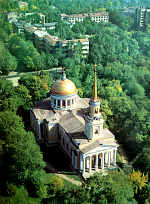
Catharine wanted to see it as a grandiose one, the city of her name. According to the project it should stretch for 20 versts in length and 15 versts in width. And Preobrazshenskiy cathedral should surpass the cathedral of St. Peter in Rome. In May 1787 during the trip of Catharine II over the south of Russia empress laid down the first stone to the foundation of Preobrazshenskiy cathedral. However construction of the city with those rates that planned was not developed.
Today this ancient construction is one of the most famous monuments of city architecture.
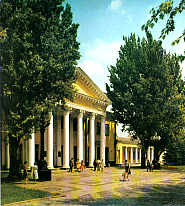
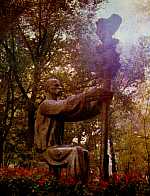
Near Preobrazshenskiy cathedral there is the oldest park in the city, which was named after T. G. Shevchenko. At the end of XVIII century Zaporozhian Cossack Lasar Globa planted on this place a large fruit garden later bought by count G. À. Potyomkin. Potyomkin palace, constructed in 1790 under the project of an architect I. Y. Starov, is the oldest building in the city.
Could effect on the fate of the city an absence of sufficient means in treasury, war with Turkey which began in 1787, accede to the throne of Pavel I, which transferred city to the category of district one and renamed it as Novorossisk in 1797. Frankly speaking, the former name, rights and privileges of Regional City were returned to Yekaterinoslav in 1802, but it has never become the capital of Russian South.
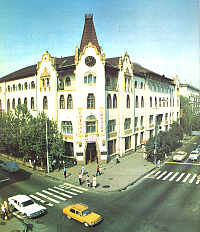
Yekaterinin Avenue laid down with metropolitan measures was not famous for it’s refinement - greens were practically absent, neglected ground neighboured with the house of the director of a factory, wine cellars and prison. Even more depressing show was represented by streets - " of ugliest kind; constant impassable dirty, where coaches often stopped and were pulled out by bullocks".
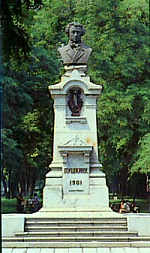
Approximately such a boring, deserted view had Yekaterinoslav when Alexander Sergeevitch Pushkin arrived here in May 1820 for " further military service ", but actually - to an exile. The poet did not stayed for a long time in Yekaterinoslav, but during half a month spent here there was an event, which served as a plot for the poem "Brothers - robbers". November 11, 1823 in his letter to P. À. Vyazemskoy Pushkin wrote: "Here it is " the Robbers ". The true incident gave me an occasion to write this fragment. In 1820, when I lived in Yekaterinoslav, two robbers, chained together, crossed through Dnieper and rescued. Their rest on an islet, their drowning of one of the guards is not invented by me".
Many known figures of a science, art and culture were seen by the city. In Yekaterinoslav lived and worked the Russian artist Flor Repnin-Fomin. Here literary activity of Russian writer Y.À. Ghana started, she was known under a pseudonym Zeneida R-voy, lived and worked Ukrainian poet-democrat I. I. Mandzshura. In different times the city was visited by Â.G. Belinskiy, I. Ê. Aivazovskiy, À. Ê. Tolstoy, Ì. S. Zshepkin, Í. I. Pirogov, I. Å. Repin, À. Ì. Gorkiy, Â. Â. Mayakovskiy, V. V. Vishnevskiy, Ìàòe Zalka, F. I. Shalapin, L. V. Sobinov. In these territories were born well-known poets Ì. A. Svetlov and À. Ì. Yasniy, Ukrainian writer G. D. Epik and sculptor Y. V. Vuchetich. The first verses of poets Ì. S. Golodniy, D. B. Kedrin, P. G. Kononenko were issued in our city.

After construction of Yekaterininskiy railway in 1884, which connected Krivorozshskiy ore field and Donetskiy coal field, Yekaterinoslav turned into the centre of ferrous metallurgy of the south of Russia. The first one was Alexandrovskiy Yushnorusskiy factory opened on May 10, 1887 - nowadays Dniepropetrovsk Metallurgical Works named after Petrovskiy.
Bryanskiy Metallurgical Works, Pipe Factory "Shoduar A", steam-locomotive-repair workshops, factories of Gantke, Lange, Mantel... To the beginning of XX century there were more than 70 industrial enterprises in the city, where worked about 20 thousand workers.
At the end of IXX century in the city with the population over 100 thousand inhabitants the first electrical tram was put into operation - earlier than in St. Petersburg and Moscow.
The rapid development of an industry made Yekaterinoslav one of the centres of struggle of the working class. There were created " Union of struggle for liberation of the working class ", Marxists circles.
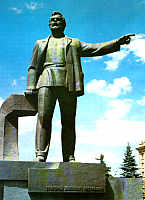

G.I. Petrovskiy – future "All-Ukrainian headman", whose name in a combination with a name of the river gave the name to the city in 1926, took an active part in revolutionary movement. There is a square and an avenue named after him in the city.
After the establishment of Soviet Power in January 1919 the inhabitants of Dniepropetrovsk had to restore the city twice - upon termination of the Civil and the Great Patriotic wars.
After the Civil war Yekaterinoslav represented a depressing show. In winter of 1920 the city was released. May be, it was not more destroyed city on all Ukraine than Yekaterinoslav... The enormous and difficult work was forthcoming.
From tens of metal-cutting factories the production was given only by a few, the transportation of loads on Yekaterininskiy railway was reduced in 35 times...
In two years all largest enterprises were practically restored and put into operation.
... War...of 22 and 23 of June 1941 – thousands of applications of voluntary entering the Red Army were handed in during the first days of war; some tens of thousands of persons went to the front; on factories and plans their place were occupied by women and teenagers; destructive troops and battalions of national home guard were organised...
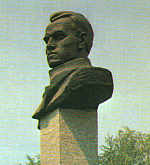
August 25 the Red Army was forced to leave Right Bank of Dniepropetrovsk. For left bank fierce battles were led up to the end of September. And later - the days of occupation.
During occupation of the city underground regional committee of the Communist party worked headed by N. I. Stashkov, 32 partisan groups, medical workers rescued youth from sending to Germany.
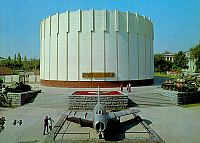
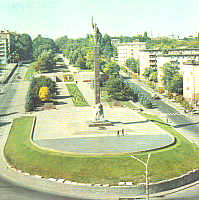
In the autumn of 1943 the armies of five soviet fronts reached the Dnieper, where was fascist defensive " East shaft ". The battle for the Dnieper started. About the events of those days reminds diorama "The battle for the Dnieper". More than 80 soldiers were awarded for this battle a rank of a Hero of Soviet Union...
Memorial dates of history, tragical and heroic events are kept in museum exhibits and documents, monuments of architecture and memorial complexes...
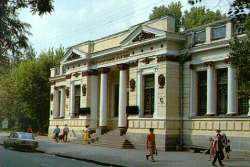

All the life was devoted to preservation of a historical heritage of Dnieper region by the researcher, historian, archaeologist, ethnographer and academician D. I. Yavornitskiy. Here he lived for 30 years and all this time he was a permanent director of a historical museum. The richest collection of antiquities of Dnieper region, assembled by the academician D. I. Yavornitskiy, consists of a significant part of funds of a museum carrying his name. At the entrance to the museum there is a unique gallery of stone women of ancient Skiffs, symbolising sources of life in Dnieper region.
What is Dniepropetrovsk like today? The wide streets direct to quay of the Dnieper, the bridges connect right bank and left bank. Modern Dniepropetrovsk, stretched on both sides of the Dnieper, is considered as industrial centre of the Ukraine.
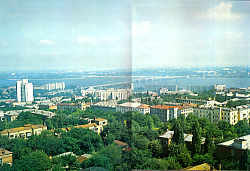
Today it’s a city of metallurgists. Here steel and pig iron are melted, roll sheets and profiles, make pipes, railway wheels, produce hardware and coke...
Today it’s a city of machine-builders. Electric locomotives and dump-cars, tractors and paper-producers, electric motors...
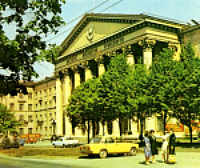
But Dniepropetrovsk is not only factories.
Dniepropetrovsk is a city of science. Here at the end of twentieth and at the beginning of the thirtieth the outstanding scientists organised scientific research institutes: academician L. V. Pisarjevskiy – The Institute of Physical Chemistry, P.I. Lebedev - The Institute of Geology, G. V. Kurdumov – The Physico-Technical Institute. Today research institutes and 9 higher schools work in the city. The Dniepropetrovsk science made many discoveries.
Old Yekaterinoslav remained twisting side-streets with small stone houses on slopes of the river bank. Dniepropetrovsk was decorated with inhabited microareas: Solnechniy, sparkling in sunny day on a bank of the Dnieper; Pobeda, shot up into the sky by high buildings; Sokol which straightened it’s wings on a high hill; Levobereshniy, Krasniy Kamen...
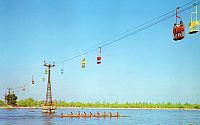
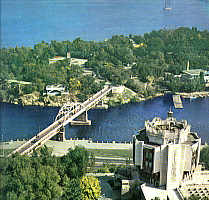
Half of the territory of the park named after T. G. Shevchenko is Komsomolskiy Island - one of the favourite places of recreation of Dniepropetrovsk inhabitants. It is connected with continental part of the park by footbridge and aerial ropeway.
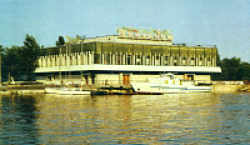
There is a botanical garden of the University in the city, and the largest in Europe aquarium of fresh-water fishes.
The city is rich by museums and exhibition halls, theatres; there is a circus, House of organ music.
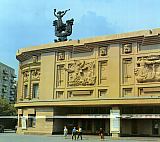
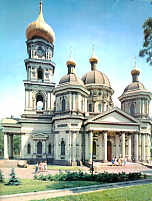
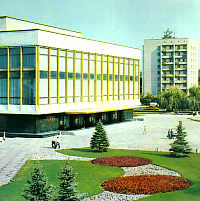
Sports complex "Meteor" with Universal Entertainment Palace of Sport contains tens of thousands of seats that allows to carry out competitions on figure skating, swimming, accept stars of a stage.

In 1995 the first line of underground was put into operation in the city.
![[ This site was designed by RedSquare Web Design Group ]](images/logorsmall.gif)